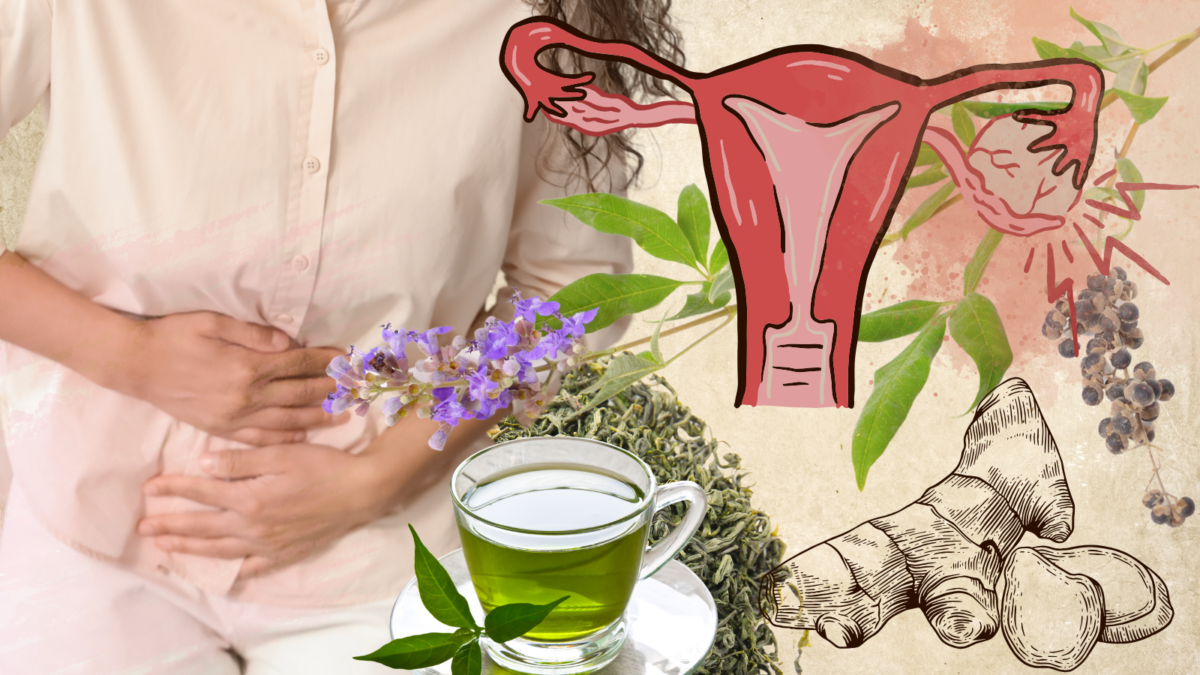Polycystic ovarian syndrome affects 15-20% of reproductive menstruating individuals globally and has been linked to infertility as well as some gynecological cancers.123 This condition is characterized by ongoing or chronic lack of egg (ovum) releases from the ovaries (the medical community calls this anovulation), excess ovarian activity where the ovaries produce too much testosterone (also referred to as androgens), low-grade chronic inflammation, insulin resistance, and obesity.
Chronic inflammation has been linked to certain diseases such as heart disease or stroke, infertility, and obesity. It may also lead to autoimmune disorders, such as rheumatoid arthritis and lupus. Insulin resistance is when cells in your muscles, fat, and liver don’t respond well to insulin and can’t use glucose from your blood for energy (can’t regulate blood sugar). To make up for it, your pancreas makes more insulin. Over time, your blood sugar levels go up. Insulin resistance syndrome includes a group of problems like already mentioned obesity, high blood pressure, high cholesterol, and type 2 diabetes. You might also hear it called metabolic syndrome.4
PCOS is the most common endocrine system disorder in menstruating individuals (1 in 10 worldwide and as many as 5 million in the US). A meta-analysis conducted by Ding et al., in 2017, reviewed the prevalence of PCOS across different ethnic groups and concluded that white females are less likely to develop PCOS compared with middle eastern and other non-white female populations.56
In addition to the physical toll, people with PCOS experience gaps in care due to provider lack of education and lack of comprehensive treatment approaches.7 People are often referred to obstetricians or gynecologists, although the health issue is endocrine system-related. Many also have been led to believe that the pain and discomfort that they feel is a normal menstrual variation and are unaware that it is a significant medical problem.
It is also crucial to know that there are environmental factors that may contribute to PCOS that are hard to account for and to address without real systemic change. These include air pollutants and endocrine-disrupting chemicals (tobacco, lead, mercury, pesticides, industrial pollutants, and microplastics).89.
Biology
The endocrine system is made up of a collection of glands and organs that regulate bodily processes using hormones. All the following are primary parts of the endocrine system: hypothalamus, pineal body, pituitary gland, thyroid and parathyroid, thymus, adrenal gland, pancreas, ovaries, and testicles. In 2017, a study found evidence that unlike assumed, the condition could start in the brain and not the ovaries, with excess androgens triggering the condition. Ovarian overproduction of androgens is a condition in which the ovaries make too much testosterone, leading to the development of male characteristics in females. Cysts on the ovaries can cause too much androgen production.10
Too many corticosteroids can also cause masculine body changes in females. Corticosteroids are man-made drugs that resemble cortisol, a hormone that your adrenal glands produce naturally. Cortisol is known as the stress hormone. Cortisol plays an important role in how your body functions in the following ways: Manages how your body uses carbohydrates, fats, and proteins; keeps inflammation down; regulates your blood pressure; increases your blood sugar (glucose); controls your sleep/wake cycle; and it boosts energy so you can handle stress and restores balance afterward. It stands to reason that prolonged, chronic trauma and adverse childhood experiences, which stimulate the release of the stress hormone cortisol, could stimulate the same aforementioned changes. In other words, these mechanisms are still unclear, as stress can be both a cause and/or a symptom. Masses on the adrenal gland or brain tumors on the pituitary can also stimulate the body into producing too much cortisol. This suggests that there are different paths that may lead to this condition, which may account for why its presentation differs across people.
Symptoms
Symptoms and combinations of signs vary and can include reproductive, endocrine, and metabolic alterations. Some common symptoms include acne, excess facial and body hair, infertility, obesity, belly fat, irregular and painful periods, absence of menstruation (also known as amenorrhea), depression, daily fatigue, sleep disorders, changes in appetite, and loss of interest in everyday activities.11 The connection to depression and anxiety is not fully understood. More than half of people with PCOS also develop type 2 diabetes by age 40.
While many people report decreased desired sexual activity with a partner, one study found that the absence of menstruation had an effect on sexual interest in activities unrelated to a sexual partner. In this case, an increase in the frequency of masturbation, which was more likely to result in orgasm. Rates of sexual satisfaction, degrees of intimacy, and communication were overall rated high.12 This implies that factors other than desire are at play, including time of cycle. These may include likelihood of pain with specific sexual activities and likelihood and desire of reaching an orgasm.
Treatment Options
Treatment often varies depending on what an individual is seeking to treat.
Pharmaceuticals
Modern pharmaceutical treatments for PCOS include:
- Anti-androgen medications: these block androgens from attaching to receptors in the body. Examples are spironolactone and cyproterone acetate (which is both antiandrogen and has progesterone properties).
- Berberine:can be used with metformin or other diabetic medications to improve their effectiveness.
- Clomifene: can help encourage ovulation in people trying to get pregnant.
- Eflornithine cream: to slow the growth of unwanted excessive hair on the face.
- Estrogen-progestin contraceptives (birth control): for the regulation of menstruation and to reduce the amount of androgens produced by the ovaries and adrenal glands. These include pills, rings, and patches.
- Letrozole: considered more effective at treating infertility caused by PCOS than clomiphene citrate.13
- Metformin: improvement of insulin sensitivity and reduced testosterone levels).
Exercise
Since exercise can actually stimulate the release of stress hormones, gentle, low-impact exercise is recommended to manage weight and for any necessary weight loss. Walking, swimming, light aerobics, and longer duration sessions of yoga and pilates are good examples. High-intensity interval training and long-distance running have also been found to be helpful for some.
Diet
Eliminate simple carbohydrates and items with processed sugar like white bread, pasta, rice, cereal, cookies, chips, and granola bars. Balance lean protein and complex carbohydrates like whole grains and brown rice. Plant-based proteins are best (legumes), as people with PCOS have been shown to have higher levels of advanced glycation end products (AGEs) which are believed to contribute to degenerative diseases, but some plant based proteins can also be harmful in large amounts. Foods high in AGEs include animal-derived and processed foods. Processed includes fried, grilled, baked, and boiled foods. These include meat (especially red meat), certain cheeses, eggs, butter, cream cheese, margarine, mayo, oils, and nuts. Dry nuts, roasted walnuts, sunflower seeds are all considered high in AGEs.14 Ways to reduce AGES include cooking methods like poaching, steaming, and using marinades (meat cooked longer and at higher temperatures has higher AGEs) and opting for poultry (skinless chicken and turkey) and fish (salmon, shrimp, tuna, cod).
Anti-inflammatory diets are recommended and the Mediterranean diet is one example. Good foods (unless you have an allergy or intolerance) to include are: leafy greens like spinach, broccoli, cauliflower, lentils, brussel sprouts, apples, pears, kiwi, avocados, and fatty fish.
It is also recommended that people with PCOS eat their highest caloric meal at breakfast as caloric timing can impact glucose, insulin, and testosterone levels.15 In a 12 week study a diet consisting of a 980-calorie breakfast, a 640-calorie lunch, and a 190-calorie dinner improved insulin, glucose and testosterone levels compared to those who ate their largest meals at dinnertime.
Supplements & Herbs1617
Artemisinin: Though the study had a small sample size, a Chinese team found that the herbal extract artemisinin may be an effective treatment for PCOS. In the study, people took the drug for 12 weeks and had more regular periods.
Ashwagandha: A plant also known as Indian Ginseng that can help balance cortisol levels and thereby improve stress and PCOS symptoms. The standard dosage of Ashwagandha for PCOS capsules is 450 to 500 milligrams (mg) daily, but the dosage can vary according to the existing complaints of PCOS. A drawback is that the herb cannot be take by people who are pregnant, breastfeeding, have Hshimoto’s hypothyroidism, have autoimmune diseases like rheumatoid arthritis and lupus, or when taking certain other supplements.
Bromelain: An enzyme derived from pineapple, and is especially useful for relieving tendonitis and healing from most physical injuries. Combined with other enzymes listed here, you get a remarkable anti-inflammatory benefit.
Chasteberry: The dried fruit and leaves of the Vitex tree. It is used to help with reproductive and endocrine conditions, like PMS, but is not recommended if you are pregnant or trying to conceive.
Chromium: This trace mineral helps to metabolize sugar better, helping stabilize insulin resistance.
Cinnamon: This spice has a positive effect on insulin resistance (reduces it) and is thought to regulate menstruation.
Evening Primrose Oil: This oil has been used to ease period pain and irregular menstruation.
Ginger: This is long known and acknowledged as a highly effective anti-inflammatory remedy that can be especially effective in gastrointestinal ills (any gut inflammatory condition), especially chronic nausea, even in early pregnancy.
Green tea: can improve insulin resistance.
Holy Basil (Tulsi): This herb can help reduce blood sugar levels, prevent weight gain, and lower cortisol levels.
Inositol: This is a B vitamin that improves insulin resistance.
Pancreatin: A type of enzyme extracted from porcine pancreas. When consumed by humans, it can get into the bloodstream very much like serrapeptase and help destroy free radicals and pro-inflammatory compounds. The net effect is a reduction of inflammation, carcinogenesis, and numerous other conditions dependent on inflammation to spread.
Probiotics: Changes in our gut microbiome are increasingly linked to many diseases, including obesity and diabetes. Probiotic supplements helped reverse symptoms of PCOS in rats.1819
Quercetin: Can improve ovulation disorders, regulate sex hormone secretion, can help with insulin resistance, and more. Dose 1000 mg.20
Serrapeptase: An enzyme derived from the silkworm that appears to be one of the most potent and effective of all the anti-inflammatory enzymes.
Turmeric: Curcumin (an extract of the spice turmeric) has been used successfully for just about every inflammatory condition. It also appears to be effective at protecting our bodies from the damaging, pro-inflammatory effects of fluoride. It also shows promise for decreasing insulin resistance.
Vitamin D: This hormone is vital for the entire endocrine system and helps with ovulation. It is common for people with PCOS to have Vitamin D deficiency. Natural sources of vitamin D are generally fatty fish. Another good supplement is, therefore, cod liver oil which can help improve menstrual regularity and decrease fat around the waist.
Zinc: This supplement can improve unwanted/excessive hair and alopecia, boost fertility, and aid the immune system.
Acupuncture
Acupuncture treatments can increase blood flow to ovaries, reduce cortisol levels, provide weight loss aid, and improve sensitivity to insulin.21
Yoga
Yoga can help manage symptoms of polycystic ovary syndrome (PCOS) by reducing stress, improving hormone balance, and increasing flexibility. Yoga can also help with menstrual discomfort and improve reproductive health overall.22
Sources

